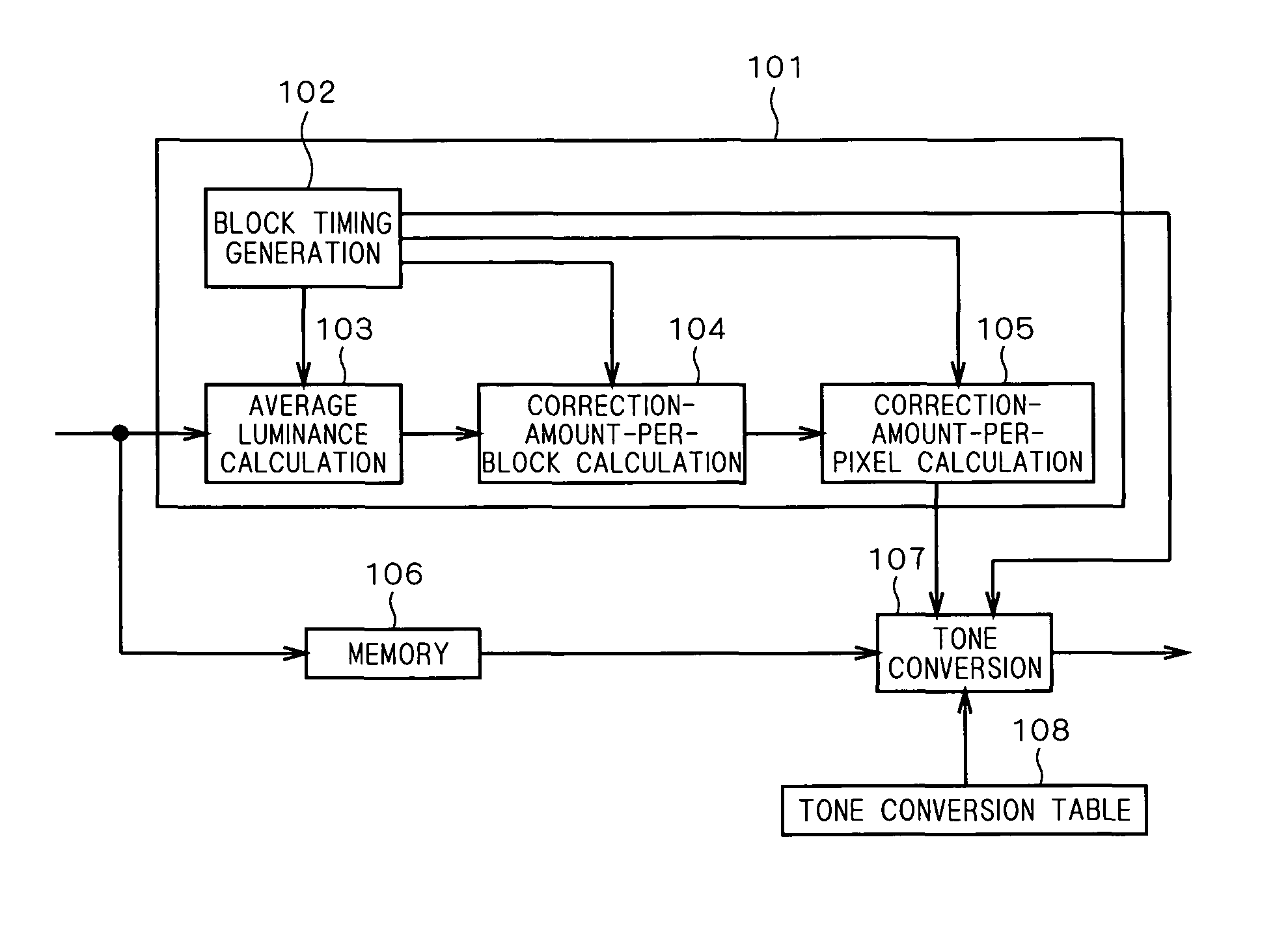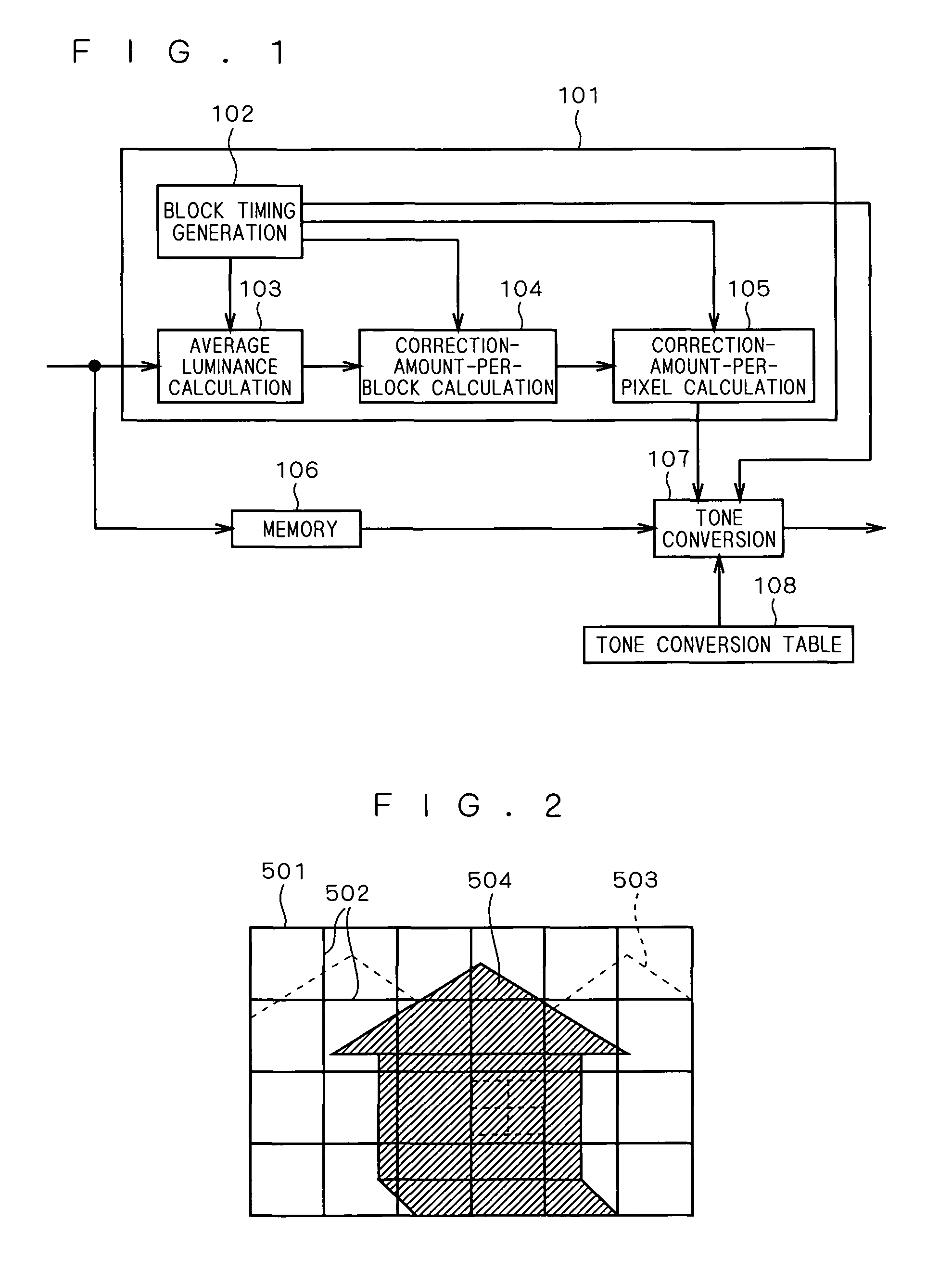Tone correction apparatus, mobile terminal, image capturing apparatus, mobile phone, tone correction method and program for improve local contrast in bright and dark regions
a tone correction and digital image technology, applied in image enhancement, color signal processing circuits, instruments, etc., can solve the problems of limiting the local contrast improvement effect of a bright region or a dark region as a whole, imposing a limit on improving the local contrast in a bright region or a dark region, etc., to achieve the effect of improving the local contras
- Summary
- Abstract
- Description
- Claims
- Application Information
AI Technical Summary
Benefits of technology
Problems solved by technology
Method used
Image
Examples
embodiment 1
[0035]The present embodiment features dividing an image area into a plurality of blocks and then controlling the amount of change from an average luminance level of each local region divided as a block to a luminance level after correction by the average luminance level of the local region. Particularly, the present embodiment features controlling the average luminance level of each local region to increase when the average luminance level of the local region is relatively lower than a median value of all luminance tone levels. Conversely, the present embodiment features controlling the average luminance level of each local region to decrease when the average luminance level of the local region is relatively higher than the median value of all luminance tone levels. Further, the present embodiment features (1) controlling a correction amount in luminance correction of a local region to increase when the average luminance level of the local region is relatively lower than the median ...
embodiment 2
[0063]The present embodiment features controlling the amount of change from the average luminance level of a local region to the luminance level after correction also by an average color-difference vector of the local region. Further, the present embodiment also features controlling the amount of change from the average luminance level of a local region to the luminance level after the correction so as to be small when the average color-difference vector of the local region is in the vicinity of almost skin color. Hereinafter, the features of the present embodiment will be described in detail on the basis of the accompanying drawings.
[0064]FIG. 8 is a diagram illustrating a block configuration of a tone correction apparatus according to the present embodiment. The configuration in FIG. 8 only differs from that of FIG. 1 in respective parts 109 and 110 in FIG. 8, and other elements are the same as corresponding elements in FIG. 1.
[0065]In FIG. 8, image data input to the tone correcti...
embodiment 3
[0096]While Embodiment 1 has described the method of carrying out conversion with a conversion table in accordance with the number of levels of correction amount at the time of obtaining luminance data after correction from the correction amount per pixel, the present embodiment carries out conversion only using two types of conversion data tables.
[0097]FIG. 13 is a block configuration illustrating a tone correction apparatus according to this embodiment. The configuration of FIG. 13 differs from that of FIG. 1 in the device configuration of the part that carries out tone conversion. The part that carries out tone conversion is comprised of a first tone conversion part 107A having a first conversion table 108A, a second tone conversion part 107B having a second conversion table 108B and a tone interpolation part 107C. As shown in FIG. 14, the first conversion table part 108A is previously provided with a mapping curve 246 for the case in which the correction amount has its maximum v...
PUM
 Login to View More
Login to View More Abstract
Description
Claims
Application Information
 Login to View More
Login to View More - R&D
- Intellectual Property
- Life Sciences
- Materials
- Tech Scout
- Unparalleled Data Quality
- Higher Quality Content
- 60% Fewer Hallucinations
Browse by: Latest US Patents, China's latest patents, Technical Efficacy Thesaurus, Application Domain, Technology Topic, Popular Technical Reports.
© 2025 PatSnap. All rights reserved.Legal|Privacy policy|Modern Slavery Act Transparency Statement|Sitemap|About US| Contact US: help@patsnap.com



